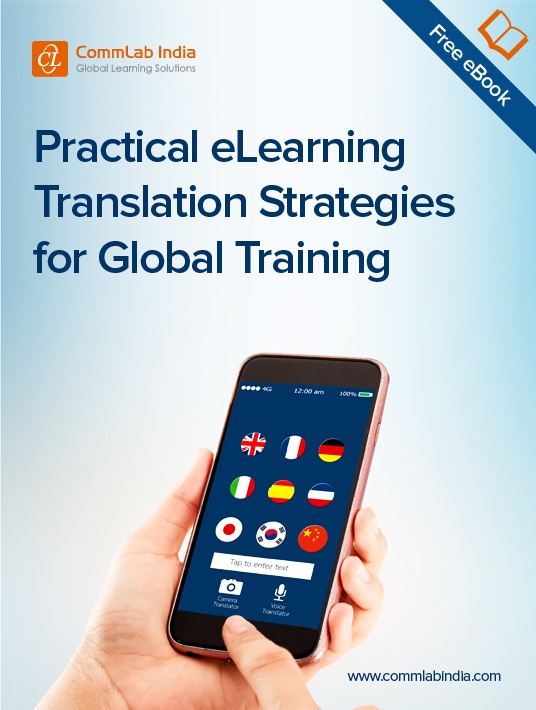The Translation Strategies You Should Not Ignore
Anyone involved in training a global workforce will tell you that globalization has shrunk our world, shortened distances, broken geographical barriers, and exposed us to cultures and traditions from around the world. The reason I say this is because translating online corporate training programs is much more than just transliteration, interpretations, or converting training courses from one language to another – it considers cultures, traditions, the length of text, and several other important elements. Read about the various translation strategies that go into making a successful global translation in this eBook.
Whether it’s a matter of creating a course that must be translated into one language or several more, translation is approached strategically, and from various viewpoints, to create a wholesomely translated version of the original; and somewhere along the way, the nuances of various cultures and traditions must be taken into consideration to make the translated text, ‘meaningful’.

1. Instructional Strategy
It starts with the fundamental structure of the course. We call it the instructional strategy. Instructional strategy is the method of presenting information to learners; and this is especially important in online training where global learners are expected to learn independently, with little or no help or guidance. They should be able to access, understand, and complete the course to the very end, with least problems.
A course’s layout has an impact on learning. For example, the open and accepting culture of the West extends its preference to open and intuitive styling of its courses; while Southeast Asia and the Middle East prefer a more rigid structure.
2. Content Strategy
Translated text reflects the original course, and how good it will end up being will depend on how crisp and translation-friendly the original content is. Sticking to International English; avoiding idioms and phrases that are strictly region-, language-, and religion-specific; and considering the sentiments of a global audience, will make the language bit of translations, easier.
3. Visual Strategy
Visuals play as important a role as text. Like the content strategy, the visual strategy must take the cultural and traditional nuances of a global workforce into account. The safest and most widely-accepted approach is one of neutrality, so it’s okay to play safe and use humanoids and vector images. If this is the approach that is chosen, text should not be embedded over the original images, as this would make it difficult to translate the embedded text.
An alternative approach would be to change the images in each translated version, to match the sentiments of the people that the course is intended for.
4. Audio Strategy
The audio strategy is important and can be approached in a variety of ways to reduce the time and costs associated with translations. Although important, it’s perfectly alright to go with less audio and more text.
Video invariably contains audio and must be made comprehensible to its audience either by translating the audio or by adding subtitles.
5. Development Strategy
The development strategy of the original course will greatly impact how appealing and user-friendly the translated version will be. A lot of time and effort goes into planning the development of the course, as it’s this strategy that brings and binds together the other strategies, to make the translated version of the course, complete. Right from designing the course, to understanding the languages that it will be translated into, understanding the needs of the multiple audiences it will eventually be shared with, understanding the method of delivery of the course in each region (on mobile devices, laptops, or desktops), and/or pre-empting the various languages it might be translated into in the future, choosing the most appropriate authoring tool to create the course to make translations easier – there is so much to comprehend and be accountable for.
6. Outsourcing Strategy
Once the original course is created, it’s time to begin the actual translation process. This involves translating the course from the original, to multiple languages. Translations cannot and should not be attempted in-house – which is why, an outsourcing strategy is necessary. This strategy involves two parts – finding a reliable translation vendor, and getting the necessary files (that this vendor will be working on), in order. The clearer and neater the source files – the easier and quicker the translations.
Final Word
It’s true that we take our training courses for granted; and we give lesser thought to translated courses – after all, how much work or effort would be required to simply translate a course from one language to another? To the ignorant viewer, it would seem the simplest thing in the world – an automatic process that could be done by a machine such as Google Translate, or perhaps a sophisticated translation tool. Well, we now know that, that is not the case. It all starts with ‘foresight’ and then the ‘creation’ of the original course; and no translation tool can do full justice to online course translations as these 6 eLearning translation strategies.
Related Articles:
- Translation And Localization Of Online Courses: Ensuring The Success Of Your Global Training
- 5 Tools To Make eLearning Translation Easy
- 5 Most Effective eLearning Localization Strategies
- Free eBook: Practical eLearning Translation Strategies For Global Training







